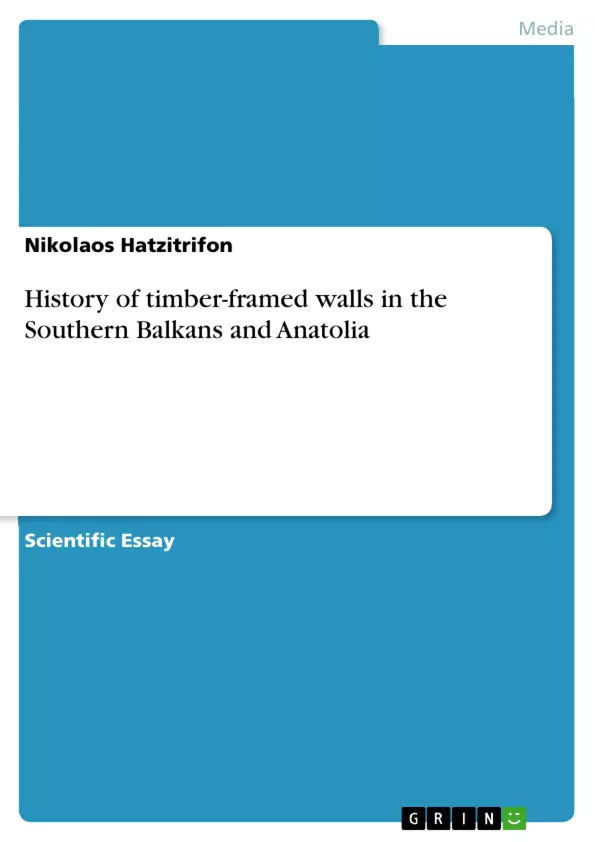To understand the technological, aesthetical and symbolic value of the surviving timber framed walls and to plan their restoration and protection, historical documentation is needed. Archaeological finds from the 16th century BC (Thera / Greece) and the 1st century AD (Herculaneum / Italy) have provided physical evidence, and written documents of 1st century BC (Vitruv) and 17th century AD (Dela Valle) give analytic description.
Allusions to these walls made up until today help us to form an idea about the development of various timber wall types, over the last three one half thousand years. The surviving buildings were generally built after the 18th century AD. Some of the main characteristics of their static system and construction will help to identify the various forms of technology, aesthetics, materials and construction procedures.
Inhaltsverzeichnis (Table of Contents)
- INTRODUCTION
- MATERIAL DOCUMENTATION OF TIMBER FRAMED WALLS
- Forerunner of timber frames
- Huts in Dispelio /Greece (50th century BC)
- Sparse timber-frames in Thera / Greece (17th century BC)
- Read constructions in Haimos (Balkans), Africa and Mesopotamia
- Timber framed walls in the antique
- Vague written descriptions
- Priamos’ chamber in Troy / Turkey
- Demosthenes’ commentary on houses, Athens / Greece
- Vitruv’s wall descriptions in Greece and Italy
- Wooden temple of Poseidon in Peloponnesus / Greece
- Heras temple in Metapontion, South Italy, ~ AD 1st century
- Excavations findings
- Vague written descriptions
- The Roman Empire's era "dark times"
- Timber framed walls around the 17th century AD
- General description
- Description of timber constructions in Istanbul
- Sporadically surviving framed walls
- Interpretations problems of historiography
- Two centuries old framed walls
- “Vitruv –type” walls
- “Herculaneum – type” walls
- Walls with diagonals
- Walls with laths covering
- The dense stud – lintel frame
- Spare timber frame
- Forerunner of timber frames
- TRANSMISSION OF TIMBER WALL TECHNOLOGY
- Timber-frame wall technology transmission by Greeks in the early Roman Empire
- Timber-frame wall technology in Balkans on the verge from Christian Roman Empire to the Ottoman one
- Wall technology in Central Europe
- Allusions for wall technology transfer during the Ottoman Empire
- Claims of other researchers
- Technical terminology as expression of state rule
- Antique
- Roman Empire era - Rom's rule
- Roman Empire era - Constantinople's rule
- Ottoman Empire era
- Era of the national states in southern Balkans
- TYPES OF TIMBER FRAMED WALLS THROUGH HISTORY
- THE CONTRIBUTION OF INFILL MATERIALS AND CLADDING
- APPRAISAL OF WOODEN WALL TYPES
Zielsetzung und Themenschwerpunkte (Objectives and Key Themes)
This article investigates the history and evolution of timber-framed walls in the Southern Balkans and Anatolia, exploring their technological, esthetical, and symbolic value. It aims to provide a comprehensive understanding of the development of timber wall types over the past three and a half thousand years, drawing on archaeological finds, surviving buildings, and historical descriptions. The article also examines the transmission of timber wall technology between different cultures and regions, focusing on the interaction between Greek, Roman, and Ottoman influences.
- The evolution of timber-framed wall construction techniques over time.
- The influence of different cultures on the development of timber wall technology.
- The relationship between timber-framed wall construction and historical events.
- The appraisal of timber-framed walls based on technical, social, and economic factors.
- The role of infill materials and cladding in determining the stability and aesthetics of timber-framed walls.
Zusammenfassung der Kapitel (Chapter Summaries)
- Introduction: This chapter sets the context for the study by outlining the importance of understanding timber-framed walls and their historical development. It highlights the prevalence of timber-framed constructions throughout history, from ancient huts to modern buildings. The chapter introduces the focus of the study, which is the Southern Balkans and Anatolia, and the need for a comprehensive examination of timber-framed wall construction in this region.
- Material Documentation of Timber Framed Walls: This chapter provides an overview of the physical and written evidence available for understanding the history of timber-framed walls. It begins with the early forerunner examples from prehistoric times, such as the huts at Dispilio and the sparse timber-frames found at Thera. The chapter then explores written descriptions from ancient Greece, including Homer's Iliad, Demosthenes' commentary, and Vitruvius' architectural treatise. It also examines archaeological findings from Herculaneum and Pompeii, which provide valuable insight into Roman-era timber-framed walls. Finally, the chapter explores the limited documentation available for the period between the Roman Empire and the Ottoman era, highlighting the need for further research.
- Transmission of Timber Wall Technology: This chapter investigates the transmission of timber wall technology between different cultures and regions. It examines the role of Greek architects in transferring technology from coastal Asia Minor and Greece to Italy during the Roman era. The chapter then explores the question of how timber-framed wall technology was disseminated during the period between the Christian Roman Empire and the Ottoman Empire. It also addresses the influence of Central European timber-framed construction on the Southern Balkans and Anatolia. The chapter concludes with a discussion of technical terminology used in different periods and regions as an indication of cultural influence and state rule.
Schlüsselwörter (Keywords)
This article focuses on timber, walls, construction, technology, and appraisal in the Southern Balkans and Anatolia. It explores key themes related to the evolution of timber-framed wall types, the transmission of construction techniques between cultures, the influence of historical events, and the evaluation of timber-framed walls based on their technical, social, and economic value.
- Citation du texte
- Dr.civ. eng. Nikolaos Hatzitrifon (Auteur), 2016, History of timber-framed walls in the Southern Balkans and Anatolia, Munich, GRIN Verlag, https://www.grin.com/document/334414



